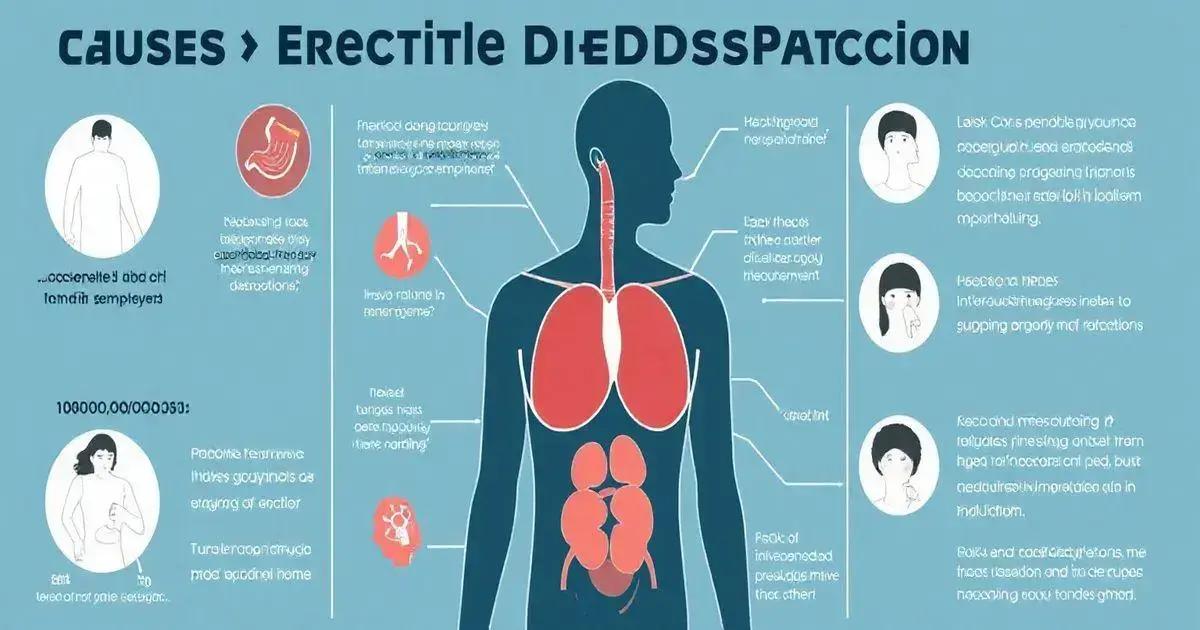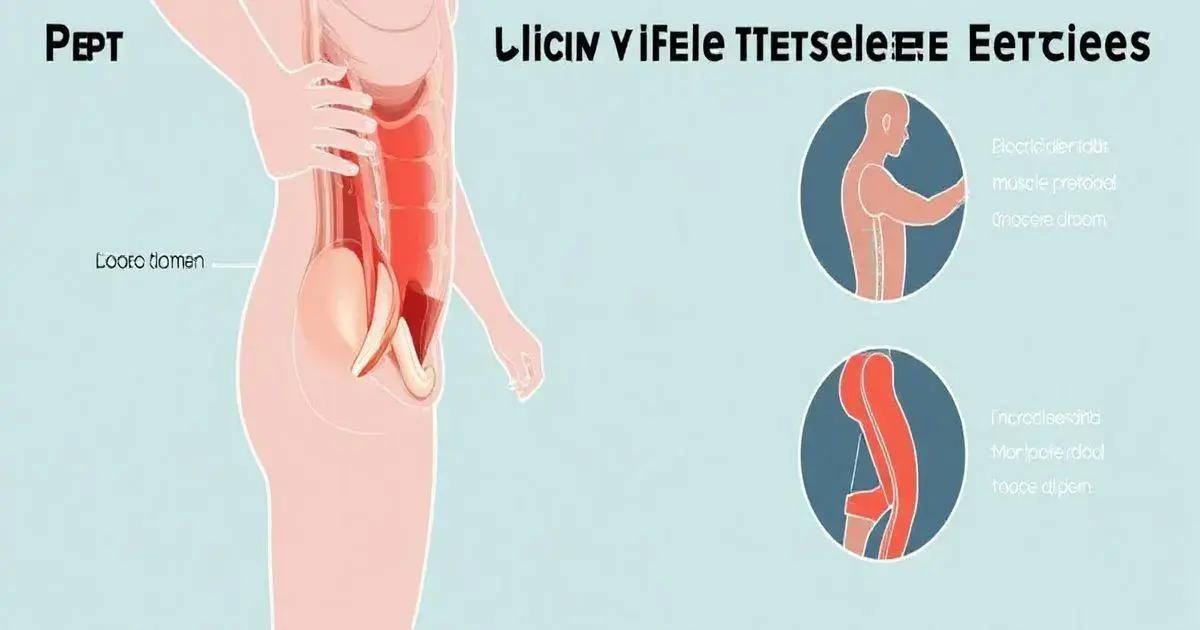Pelvic floor exercises play a vital role in managing erectile dysfunction by strengthening pelvic muscles, improving blood flow, and enhancing overall sexual function, while also providing additional benefits like better bladder control, core stability, and reduced stress. Consulting a healthcare professional is essential for personalized treatment and guidance.
Erectile dysfunction (ED) affects many men, often leading to stress and lower self-esteem. The role of pelvic floor exercises in erectile dysfunction can be a game-changer. These exercises improve muscle strength and blood flow, contributing to better sexual health. In this article, we’ll dive into how these specific exercises can aid in overcoming ED, explore effective techniques, and highlight additional benefits that come from strengthening your pelvic floor.
Understanding Erectile Dysfunction

Erectile dysfunction (ED) is a condition that affects many men at different stages of their lives. It refers to the inability to achieve or maintain an erection suitable for sexual activity. Understanding erectile dysfunction is important for addressing health and wellness issues that may arise due to this condition.
Causes of Erectile Dysfunction
Several factors contribute to erectile dysfunction. These can be physical, such as diabetes, heart disease, obesity, hormonal imbalances, or nerve damage. Additionally, psychological factors like stress, anxiety, or depression can also play a significant role in ED.
Symptoms and Diagnosis
The primary symptom of erectile dysfunction is the consistent difficulty in getting or keeping an erection. If this problem persists, it is crucial to consult a healthcare provider. Diagnosis may involve a physical exam, medical history review, and possibly blood tests to assess hormone levels and other potential health issues.
Risk Factors
Various risk factors can increase the likelihood of developing erectile dysfunction. These include a sedentary lifestyle, smoking, excessive alcohol consumption, and certain medications. Understanding these risk factors can help in preventing or managing ED.
Impact on Quality of Life
Erectile dysfunction can affect more than just sexual health; it can also impact relationships and emotional well-being. Open communication with partners and seeking support from healthcare professionals can be beneficial in managing the condition.
How Pelvic Floor Exercises Help

Pelvic floor exercises play a crucial role in improving erectile dysfunction (ED) by enhancing muscle strength and blood circulation. These exercises focus on the muscles that support the bladder and bowel, as well as those that control erections.
Strengthening Pelvic Muscles
When you regularly engage in pelvic floor exercises, you strengthen the muscles at the base of the pelvis. Stronger pelvic muscles can lead to better erection quality, making it easier to achieve and maintain an erection.
Improving Blood Flow
One of the key factors contributing to erectile dysfunction is poor blood flow to the penis. Pelvic floor exercises can help improve circulation in this area. Increased blood flow can facilitate stronger erections during sexual activity.
Enhancing Sexual Function
In addition to helping with ED, these exercises can contribute to overall sexual function. Men who perform pelvic floor exercises may experience improved sexual sensation and control, leading to greater confidence and satisfaction.
Reducing Stress and Anxiety
Pelvic floor exercises can also aid in reducing stress and anxiety, which are significant psychological factors affecting erectile dysfunction. By incorporating relaxation techniques and mindfulness during these exercises, men may find themselves feeling more at ease, further improving their sexual health.
Incorporating Exercises into Daily Life
Finding time to perform pelvic floor exercises can be easy. Simple activities like Kegel exercises can be done discreetly throughout the day. By making these exercises a habitual part of your routine, you can reap the long-term benefits for your sexual health.
Key Exercises to Practice

Practicing specific pelvic floor exercises can lead to significant improvements in erectile dysfunction. Here are some key exercises to consider:
Kegel Exercises
Kegel exercises strengthen the pelvic floor muscles. To perform these, squeeze the muscles you use to stop urination and hold for 3-5 seconds. Relax and repeat this 10-15 times. Try to do this at least three times a day.
Bridge Exercise
The bridge exercise not only targets the pelvic floor but also works the glutes and lower back. Lie on your back with knees bent and feet flat on the floor. Lift your hips towards the ceiling while tightening your pelvic muscles. Hold for a few seconds and lower back down. Repeat 10-15 times.
Tailor Sitting
This exercise promotes flexibility and relaxation of the pelvic area. Sit cross-legged with your back straight and gently push your knees down towards the ground while focusing on breathing deeply. Hold this position for a few breaths.
Squats
Do squats to strengthen your legs and pelvic floor. Stand with feet shoulder-width apart, lower your body as if sitting back into a chair, and keep your chest up. Make sure your knees do not go past your toes. Perform 10-15 repetitions.
Hip Thrusts
Hip thrusts are effective for activating the pelvic floor. Sit on the ground with your upper back against a bench, and roll a barbell or weight on your hips. Push through your heels and lift your hips towards the ceiling, squeezing your pelvic floor at the top. Lower back down and repeat for 10-12 reps.
Benefits Beyond Erectile Dysfunction

Pelvic floor exercises provide numerous benefits beyond addressing erectile dysfunction. Here are some key advantages:
Improved Bladder Control
Strengthening the pelvic floor can enhance bladder control. This helps reduce urinary incontinence, allowing individuals to enjoy life without the fear of leaks.
Enhanced Sexual Function
These exercises can lead to improved sexual performance. Not only do they help with ED, but they can also increase sensitivity and pleasure during sexual activities.
Better Core Stability
The pelvic floor plays a key role in core stability. Strong pelvic muscles support the spine, reducing the risk of injury during physical activities.
Improved Posture
By engaging the pelvic floor, individuals may notice an improvement in posture. This contributes to less strain on the back and can help alleviate discomfort.
Support During Aging
As men age, pelvic floor strength tends to decline. Regular exercises can maintain or even improve muscle tone, contributing to better overall health and functionality in later years.
Reduction of Stress and Anxiety
Practicing pelvic floor exercises can promote relaxation and mindfulness. By focusing on breath and muscle control, these exercises may help reduce stress and anxiety levels.
Consulting a Healthcare Professional

Consulting a healthcare professional is essential for anyone facing erectile dysfunction. They can provide a proper diagnosis and treatment plan tailored to individual needs.
Understanding the Importance
A healthcare professional, such as a urologist or primary care doctor, can help identify if the ED is linked to underlying health conditions like diabetes, heart disease, or hormone issues. Getting to the root of the problem is crucial.
Personalized Treatment Plans
Each patient is unique, and treatment for ED varies accordingly. A doctor can recommend appropriate pelvic floor exercises, medications, or other therapies based on personal health history and circumstances.
Monitoring Progress
Regular check-ups allow for monitoring the effectiveness of the chosen treatment. It is important to discuss any changes in symptoms or side effects of medication with a healthcare provider.
Addressing Psychological Aspects
Sometimes, erectile dysfunction can have psychological roots, such as anxiety or depression. A healthcare professional can guide patients in seeking therapy or counseling if needed.
Staying Informed
Healthcare professionals can provide information about lifestyle changes that may enhance treatment outcomes. This includes diet, exercise, and limiting alcohol or tobacco use.
Understanding the Role of Pelvic Floor Exercises
Pelvic floor exercises are not only key in managing erectile dysfunction but also offer multiple benefits for overall health. By effectively strengthening the pelvic muscles, individuals can experience improvements in bladder control, sexual function, and even core stability.
Consulting a healthcare professional is an essential step for anyone facing erectile dysfunction. They provide a comprehensive evaluation and tailor a treatment plan that meets individual needs.
Incorporating these exercises into a daily routine can lead to lasting improvements, boosting confidence and well-being. As awareness grows, more men can seek help and realize the holistic benefits of pelvic floor exercises.
Ultimately, prioritizing pelvic health is a crucial aspect of maintaining vitality and quality of life.
FAQ – Frequently Asked Questions About Pelvic Floor Exercises and Erectile Dysfunction
What are pelvic floor exercises?
Pelvic floor exercises are movements that strengthen the muscles in the pelvic region. They can help improve muscle control and sexual function.
How do pelvic floor exercises help with erectile dysfunction?
These exercises can improve blood flow, increase muscle strength, and enhance overall sexual function, aiding in the management of erectile dysfunction.
What are some key pelvic floor exercises to practice?
Key exercises include Kegel exercises, bridges, squats, and hip thrusts, all of which target the pelvic muscles effectively.
Can I do pelvic floor exercises on my own?
Yes, pelvic floor exercises can be done individually and discreetly throughout the day. Consistency is key for best results.
Should I consult a healthcare professional about erectile dysfunction?
Absolutely. Consulting a healthcare professional is essential to identify the underlying causes of erectile dysfunction and to receive a tailored treatment plan.
Are there benefits beyond erectile dysfunction for pelvic floor exercises?
Yes, benefits can include improved bladder control, enhanced sexual function, better core stability, and reduced stress and anxiety.












